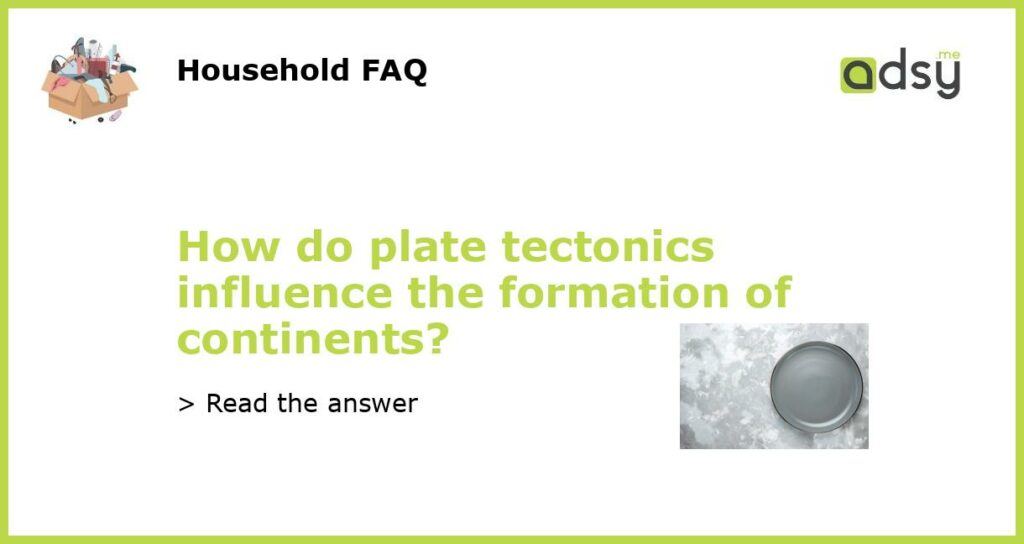Plate Tectonics and the Formation of Continents
Plate tectonics is the scientific theory that explains the movement and interaction of the Earth’s lithosphere, which consists of several large and small plates. These plates are constantly shifting and colliding with one another, leading to various geological phenomena such as earthquakes, volcanic eruptions, and the formation of mountain ranges. The process of plate tectonics plays a crucial role in the formation and arrangement of continents on our planet.
Continental Drift: The Initial Step
The theory of plate tectonics originated from the earlier concept of continental drift proposed by German scientist Alfred Wegener in the early 20th century. Wegener suggested that the Earth’s continents were once part of a single, supercontinent called Pangaea and have gradually moved apart over millions of years. This movement of continents would not have been possible without the underlying process of plate tectonics.
Plate tectonics explains how the lithospheric plates, which carry the continents, are driven by the convective flow of the underlying, semi-fluid asthenosphere. As the plates move, they slowly rearrange the continents, creating new ocean basins and changing the global geography over time.
Divergent Boundaries: Formation of New Oceanic Crust
At divergent boundaries, two tectonic plates move away from each other. These boundaries are often found in the middle of the oceans, where new crust is constantly being formed. As the plates separate, molten material called magma rises from the Earth’s mantle and fills the gap, solidifying to form new oceanic crust.
Over time, this process of seafloor spreading allows for the formation of new ocean basins, pushing the continents further apart. For example, the Mid-Atlantic Ridge is a divergent boundary where new crust is being continuously formed, moving the continents of North America and Europe away from each other.
Convergent Boundaries: Collision and Mountain Building
Convergent boundaries occur when two plates move towards each other. Depending on the types of plates involved, this can result in different geological processes, including subduction and collision.
In subduction zones, where an oceanic plate collides with a continental plate, the denser oceanic plate sinks below the continental plate into the asthenosphere. This process results in the formation of deep ocean trenches, volcanic activity, and the creation of mountain ranges, such as the Andes in South America.
When two continental plates collide, neither plate subducts as both are relatively buoyant. Instead, the plates crumple and fold, forming extensive mountain systems like the Himalayas in Asia. These collisions can cause significant uplift and deformation of the Earth’s crust, leading to the formation of large-scale geological features.
Transform Boundaries: Shifting and Earthquakes
Transform boundaries occur when two plates slide past each other horizontally. These boundaries are characterized by fault lines, where significant amounts of energy can be stored and released, resulting in earthquakes.
Transform boundaries play a vital role in the plate tectonic system, as they accommodate the lateral movement of the plates. The San Andreas Fault in California is a well-known example of a transform boundary, where the Pacific Plate and the North American Plate are sliding past each other.
Hotspots: Volcanic Activity and Island Formation
In addition to the interactions between tectonic plates, hotspots are another factor that influences the formation of continents. Hotspots are areas of volcanic activity that occur in the middle of tectonic plates, far from the plate boundaries.
Hotspots are believed to be caused by an upwelling of hot material from deep within the Earth’s mantle, creating a stationary plume of magma. Over time, as the tectonic plates shift, the hotspots can create a chain of volcanic islands, such as the Hawaiian Islands.
The process of plate tectonics is a fundamental driver of the formation and arrangement of continents on our planet. Through the movements and interactions of tectonic plates at various types of plate boundaries, new crust is formed, old crust is destroyed, and continental landmasses shift and collide with each other. This ongoing process shapes the Earth’s geography and contributes to the dynamic nature of our planet.






